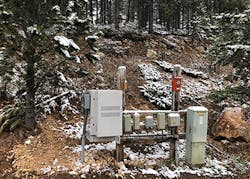Latest from Core/Legacy
Quiz: Are You a Telecom History Scholar?
400 Columns + One Farewell
A 5-Step Broadband Strategy —
Broadband connectivity is essential now more than ever to battle our nation’s Digital Divide problem.
• Some studies have calculated that 83 million people in the USA lack access to high-speed Internet services — many of whom live in rural areas.
• Other statistics indicate that during the current COVID-19 pandemic, 30 million underserved Americans are not able to access telehealth and online learning resources that are desperately needed.
• Scenes of Americans parked outside fast food restaurants, trying to get Internet connectivity are all too common.
• In one instance, a parent drove her son from their family farm to the nearest hill so that he could participate in Zoom classroom meetings.
InvisiLight® Solution for Deploying Fiber
April 2, 2022Go to Market Faster. Speed up Network Deployment
April 2, 2022Episode 10: Fiber Optic Closure Specs Explained…
April 1, 2022Food for Thought from Our 2022 ICT Visionaries
April 1, 2022Existing Multi-Service Access Platforms (MSAPs) have significant embedded bases that can play a critical role in closing these broadband service gaps in metropolitan, suburban, exurban and rural areas. These MSAP systems already connect millions of homes and businesses across the USA. Consequently, many Service Providers can upgrade and expand existing MSAP systems to deliver 100M/20M, 50M/5M, and 25M/3M, Internet connectivity. These existing MSAPs are an ideal platform for both large and small network operators participating in Connect America Fund and Rural Digital Opportunity Fund (RDOF) broadband stimulus programs.
5 Steps to Take
Here are the 5 steps a broadband service provider can take to better serve the underserved and unserved in an economical, timely and efficient manner.
1. Identify which MSAP systems can reach the underserved and unserved customers.
2. Upgrade and expand these existing, and already operationalized MSAP systems with xDSL.
3. Expand bandwidth capacity of MSAP systems and shelves using gigabit Ethernet.
4. Aggregate gigabit Ethernet ports to 10 gigabit Ethernet and wave division multiplexing transport.
5. Hire qualified professional services to assist to supplement your internal resources.
Detail About Each of the 5 Steps
Step 1: Identify Existing MSAPs
It all starts with identifying which MSAP systems can reach the underserved and unserved customers within the network operator’s territory.
• These MSAP systems are typically located in small or large Central Offices (CO), and Remote Terminals (RT) in either enclosures, cabinets, or huts.
• A number are also located on customer premises locations.
• They may also have a mix of fiber and copper-based technologies.
Telecom service providers for many years have counted on these MSAP systems to collapse, converge, and connect, their access networks in a cost-effective manner that leverages existing approved equipment and infrastructure. These MSAP systems often support a wide variety of technologies, including, but not limited to, Ethernet, xDSL, TDM, and ATM.
Step 2: Upgrade Targeted MSAPs
Once located and analyzed, these targeted MSAP systems that are already operationalized within the network operator’s business, can be upgraded and expanded. This helps deliver a broadband expansion solution in the fastest time to market and in the most economical means possible.
These MSAPs can be used for high-speed Internet over copper for both residential and business customers, especially in exurban and rural areas where fiber distribution facilities are rarely available. This provides network operators with the ability to leverage the existing copper plant to maximizing connectivity options for DSL, while strategically growing the new fiber deployments.
With these options available, additional broadband xDSL service cards can be added to support higher speeds through bonding, and more customers through the addition of high-speed subscriber ports.
This combination of higher speeds and additional customer capacity helps stem the erosion of the customer base and, more importantly, results in additional revenue for the network operator.
Step 3: Expand MSAP Bandwidth Capacity
Often these MSAP systems offer a variety of shelf transport options. Their capacities and technologies can be flexible to fit the network operator’s applications. For example, these MSAP systems may have OC3 or OC12 transport across the outside plant from CO to the RT. If that is the case, service providers can enhance the performance of those MSAP chassis and maximize their transport capacity by installing gigabit
Ethernet uplink cards into the same shelf as the xDSL service cards.
With gigabit Ethernet connectivity to the shelf, bandwidth capacity is enhanced and xDSL speeds can be increased to homes and businesses served by the MSAP system.
Step 4: Aggregate MSAP Backhaul
A service provider also has the option to aggregate multiple gigabit Ethernet ports by installing a 10 Gigabit Ethernet plug-in card. This allows for the aggregation of broadband traffic transport from multiple 1 gigabit cards (i.e., shelves), enabling the highest possible DSL speeds over the MSAP system.
Having a 10 gigabit Ethernet option helps enhance the MSAP shelf capacity, saves on service providers’ capital expenditures by aggregating individual gigabit Ethernet ports, and maximizes revenue from DSL, Ethernet, and other business services.
Another valuable benefit of gigabit aggregation is the optimization of OSP fiber utilization. Quite often, spare fiber is a scare resource, especially in exurban and rural areas. This aggregation capability provides for higher bandwidth capacity, while minimizing fiber requirements. It even provides for "re-use" of the same fiber at multiple RT sites in a single feeder route.
Complementing the fiber utilization benefits, there is also the option to use a Wave Division Multiplexing (WDM) system for economic relief of broadband exhaustion. This is accomplished by the addition of a passive optical multiplexing solution that provides multiple wavelengths from the CO to the RT. With this CWDM solution in place, alternate wavelengths on existing fiber cable can now support additional 10 gigabit backhaul transport to resolve bandwidth exhaust, while avoiding the need for additional fiber facilities.
Step 5: Supplement Internal Resources
Broadband service providers should also consider tapping into outside professional services to assist with these broadband upgrade projects. By supplementing with professional services, a network operator can plan, build, and operate, these expansion projects in a more economical manner.
• For example, network consultation services used for planning and design can help accelerate the development of network expansion and enable quick turn-up of these services.
• Deployment services can also be leveraged to quickly deploy and test equipment with minimal impact to existing operations.
• Once the broadband network is operational, then outside professional services can be added for resident engineering help, software upgrade assistance, and customer scripting, to automate tedious, yet critical tasks.
By supplementing internal resources, this allows internal staff to stay focused on core business.
Like this Article?
Subscribe to ISE magazine and start receiving your FREE monthly copy today!
There has been great progress from the Federal Communications Commission (FCC) over the past couple of years steadily advancing the Connect America Fund (CAF) and Rural Digital Opportunity Fund (RDOF) programs that promise faster broadband speeds to help close the Digital Divide in many rural areas.
Tellabs stands ready to help with economic options utilizing telecom providers’ existing Tellabs® 1000 MSAP embedded bases for these broadband expansion projects in underserved and the unserved areas. This iconic MSAP can provide flexible deployment, broad offerings, and the highest capacity services at the lowest first time and total ownership costs.










